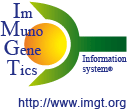Only-heavy-chain antibodies
Excerpt of: Lefranc M-P. IMGT® immunoglobulin repertoire analysis and antibody humanization.
In: Alt, F.W, Honjo, T, Radbruch A. and Reth, M. (Eds.), Molecular Biology of B cells, Second edition, Academic Press, Elsevier Ltd, London, UK, Chapter 26, 2014, PP. 481-514.
dx.doi.org, ISBN : 978-0-12-397933-9. LIGM: 438
page 509-510 (source above to be quoted)
4.4.3.1 Dromedary IgG2 and IgG3 only-heay-chain antibodies
Two IgG antibody formats are expressed in the dromedary or Arabian camel (Camelus dromedarius) and in
Camelidae in general: the conventional IG (with two identical heavy gamma chains associated to two identical
light chains) and the 'only-heavy-chain' IG (no light chain, and only two identical heavy gamma chains
lacking CH1) (96). The Camdro (for Camelus dromedarius in the 6-letter species abbreviation) IGHV1 genes
belong to two sets based on four amino acid changes which are characteristic of each set (97). The first
set of IGHV1 genes is expressed in conventional tetrameric IgG1 that constitute 25% of circulating antibodies.
The second set is expressed in the only-heavy-chain antibodies, IgG2 and IgG3 that constitute 75% of the
circulating antibodies (96). The four amino acid changes are located in the FR2-IMGT at positions 42, 49,
50 and 52, the first position 42 is in the C strand and the three others (49, 50 and 52) in the C' strand.
They belong to the [GFCC'C'] sheet at the hydrophobic VH-VL interface in conventional
antibodies of Camelidae as well as of any vertebrate species whereas, in camelid only-heavy-chain antibodies
(no light chains, and therefore no VL), these positions are exposed to the environment with, through evolution,
a selection of hydrophilic amino acids.
The respective heavy gamma2 and gamma3 chains are both characterized by the absence of the CH1 domain owing
to a splicing defect (98). It is the absence of CH1 which is responsible for the lack of association of the
light chains. Only-heavy-chain antibodies is a feature of the Camelidae IG as they have also been found in the
Bactrian camel (Camelus bactrianus) of Central Asia and in the llama (Lama glama) and alpaca (Vicugna pacos)
of South America. The genetic event (splicing defect) responsible for the lack of CH1 occurred in their common
ancestor before the radiation between the 'camelini' and 'lamini', dating approximately 11 million years (Ma) ago.
The V domains of Camelidae only-heavy-chain antibodies have characteristics for potential pharmaceutical applications
(e.g., easy production and selection of single-domain format, extended CDR3 with novel specificities and binding
to protein clefts). They are designated as VHH when they have to be distinguished from conventional VH (the sequence
criteria is based on the four amino acids at positions 42, 49, 50 and 52). The term 'nanobody' initially used for
describing a single-domain format antibody is not equivalent to VHH, as it has been used for V domains other than
VHH and for constructs containing more than one V domain (VH and/or VHH) (e.g., caplacizumab, ozoralizumab) (IMGT®
http://www.imgt.org, IMGT Repertoire > Locus and Genes > Gene tables; ibid., IMGT Biotechnology page > Characteristics
of the camelidae (camel, llama) antibody synthesis; ibid. IMGT/mAb-DB > caplacizumab; ibid. IMGT/mAb-DB > ozoralizumab).
4.4.3.2 Human heavy chain diseases (HCD)
The camelidae only-heavy-chain antibodies synthesis is remarkably reminiscent of what is observed in human heavy chain diseases (HCD). These proliferative disorders of B lymphoid cells produce truncated monoclonal immunoglobulin heavy chains which lack associated light chains. In most HCD, the absence of the heavy chain CH1 domain by deletion or splicing defect may be responsible for the lack of assembly of the light chain (99). Similar observations have also been reported in mouse variants (99) (IMGT® http://www.imgt.org, IMGT Education > Pathology of the immune system > Molecular defects in Immunoglobulin Heavy Chain Diseases (HCD); ibid., IMGT Lexique > Heavy Chain Diseases (HCD)).
4.4.3.3 Nurse shark IgN
A convergence mechanism in evolution is observed in nurse shark (Ginglymostoma cirratum, 'Gincir' in the 6-letter species abbreviation) IgN antibodies (previously IgNAR, 'immunoglobulin new antigen receptor') (100) which are only-heavy-chain antibodies (homodimeric heavy nu chains without CH1, and no associated light chains). The IGHV genes expressed in the Gincir heavy nu chains belong to the IGHV2 subgroup and are characterized by the absence of the CDR2-IMGT owing to a deletion that encompasses position 54 to 67. The Gincir IGH genes are organized in duplicated cassettes, and those that express IgN comprise Gincir IGHV2 subgroup genes and an IGHN constant gene (IMGT® http://www.imgt.org, IMGT Repertoire > Proteins and alleles > Protein display > IGHV > nurse shark (Ginglymostoma cirratum); ibid., IMGT Repertoire > Locus and genes > Gene tables > IGHV > Chondrichthyes).
(96) Hamers-Casterman, C., Atarhouch, T., Muyldermans, S., Robinson, G., Hamers, C., Bajyana Songa, E., Bendahman, N., and Hamers, R. (1993). Naturally occurring antibodies devoid of light chains. Nature 363, 446-448.
(97) Nguyen, V.K., Hamers, R., Wyns, L., and Muyldermans, S. (2000). Camel heavy-chain antibodies: diverse germline VHH and specific mechanisms enlarge the antigen-binding repertoire. EMBO J. 19, 921-930.
(98) Nguyen, V.K., Hamers, R., Wyns, L,. and Muyldermans, S. (1999). Loss of splice consensus signal is responsible for the removal of the entire CH1 domain of the functional camel IgG2a heavy chain antibodies. Mol Immunol. 36, 515-524.
(99) Lefranc, M.-P., and Lefranc, G. (1988). The constant region genes of the immunoglobulin heavy chains. Mol Genet. (Life Sci. Adv.) 7, 39-45.
(100) Greenberg, A.S., Avila, D., Hughes, M., Hughes, A., McKinney, E.C., and Flajnik, M.F. (1995). A new antigen receptor gene family that undergoes rearrangement and extensive somatic diversification in sharks. Nature 374, 168-173.
- Camelidae IgG antibodies (The IMGT Biotechnology page)
- Molecular defects in Immunoglobulin Heavy Chain Diseases (HCDs) M.-P. Lefranc and G. Lefranc (IMGT Education)



